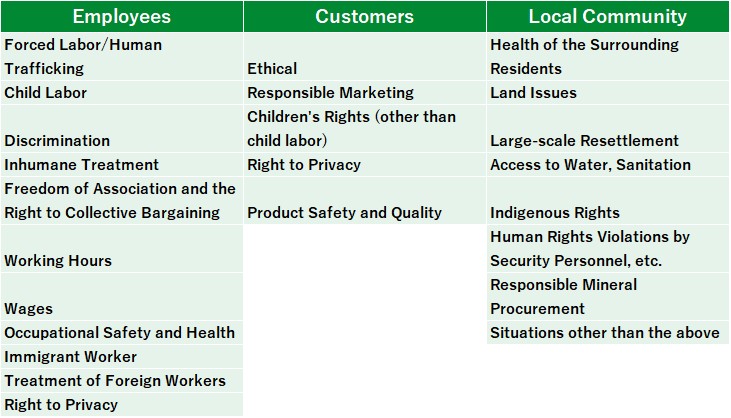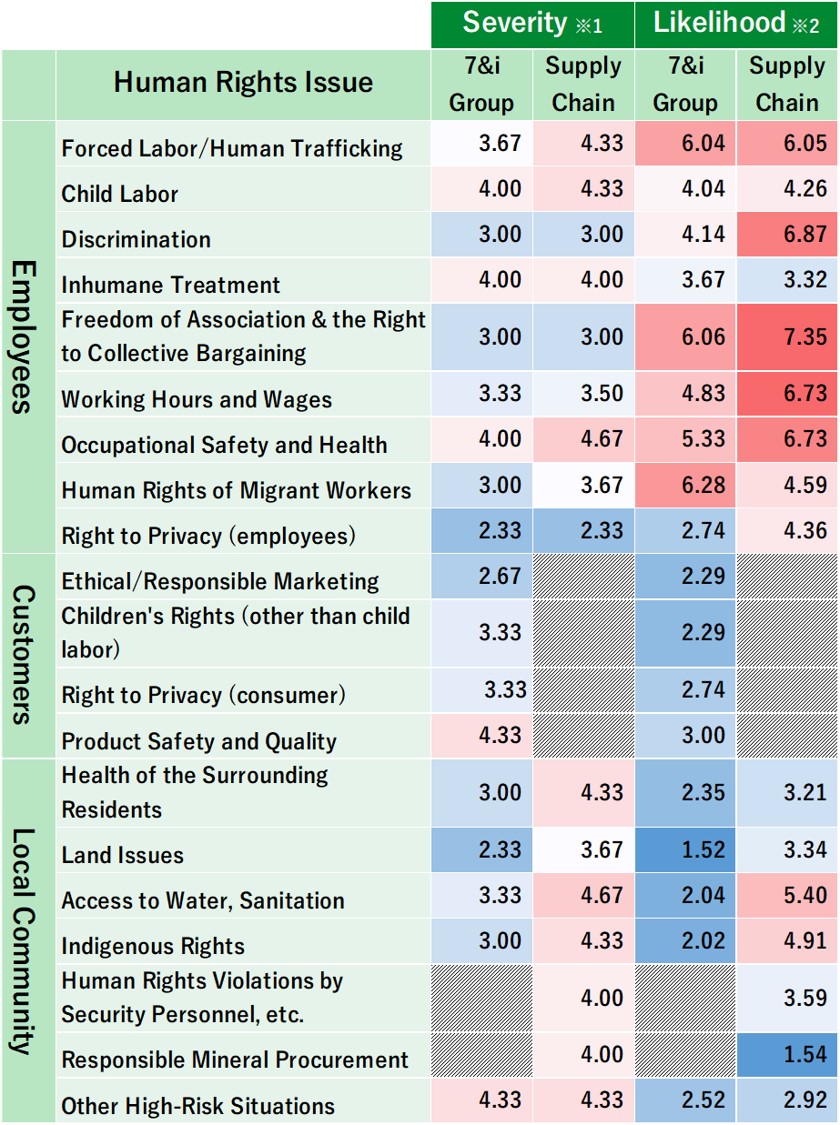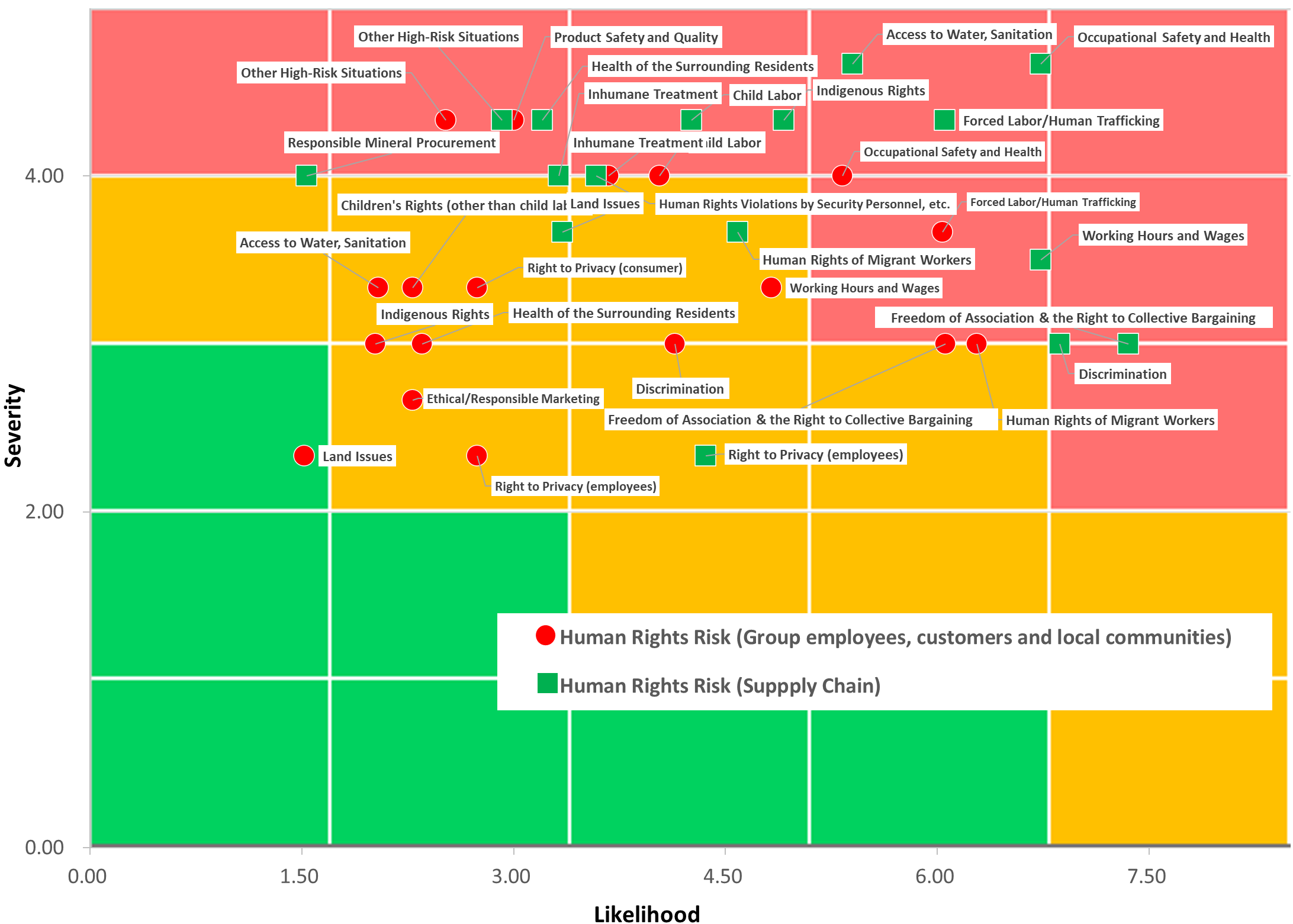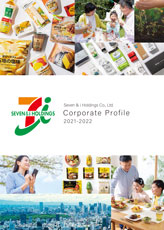- Top
- Sustainability
- Human Rights Initiatives
- Human Rights Risk Assessment
- Sustainability
- Statement
- Message from the Representative Director & Executive Chair (Kaicho)
- Basic Policies of Sustainability Initiatives
- Sustainability Management
- Stakeholder Engagement
- Business Partners
- Seven & i Holdings Material Issues
- Compliance
- Information Security and Personal Information Protection
- Human Rights Initiatives
- Human Capital Initiatives
- Responses to Climate Change (TCFD) and Nature (TNFD)
- Response Based on the Taskforce on Climate-related Financial Disclosures (TCFD)
- Taskforce on Nature-related Financial Disclosures (TNFD)
- Social Contribution Activities
- Disaster Reconstruction Support
- Disaster Assistance
- Overseas Initiatives
- Sustainability Data Book
- External Recognition and Awards
- SASB/GRI Index
- Index for Researchers
- Keyword search
- Editorial Policy
- Social
- Environment
Human Rights Risk Assessment
Human Rights Risk Assessment Objectives
The Seven & i Group (hereinafter referred to as "we") respects the human rights of all people and engages in business activities that contribute to the development of society together with all stakeholders based on the spirit of "trust and integrity" set forth in our corporate motto. In order to respect the human rights of all people in our value chain, we established the "Group Human Rights Policy" in 2021 and are working to respect the human rights of all people through our core business activities. We support the Universal Declaration of Human Rights, the OECD Guidelines for Multinational Enterprises, the ILO International Labor Standards, the UN Guiding Principles on Business and Human Rights, and ISO 26000, and are a signatory to the UN Global Compact. We recognize that our business activities may impact human rights, and we are committed to establishing a system of human rights due diligence in accordance with procedures based on the UN Guiding Principles on Business and Human Rights, to resolve human rights issues, and to help realize a sustainable society. In resolving human rights issues, we have identified the human rights challenges of key stakeholders related to the Group's business activities.
Human Rights Risk Assessment Process
Step 1: Organize stakeholders in the value chain and human rights issues
While taking into account the Group's value chain and business activities, we identified human rights risks and organized human rights issues based on interviews with each of the Group's operating companies and the results of CSR audits.
Step 2: Human rights risk assessment within the Group and its supply chain
Human rights risk assessments were conducted for the businesses of major group companies (14 businesses) and business partners (122 businesses).
Step 3: Creating a Human Rights Risk Map
Based on the human rights risk assessment, a severity score and a likelihood of occurrence score were calculated for each human rights issue and mapped to each.
Step 4: Information Disclosure
The process and results of Steps 1-3 were made publicly available on the website.
■ External Review and Evaluation Criteria
Throughout the entire process, we exchanged views and obtained advice from experts in the field of human rights. In identifying and assessing negative impacts, we utilized the Business and Human Rights Resource Centre (BHRRC) database and conducted research on internationally identified human rights issues in the industry.
Forced labor: Walk Free Foundation, The Global Slavery Index
Child labor: Global Child Forum & UNICEF, Children's Right and Business Atlas
Discrimination: (1) World Economic Forum, The Global Gender Gap Report
(2) Minority Rights Group International, Peoples Under Threat
Freedom of association and the right to collective bargaining: International Trade Union Confederation,
The Global Rights Index
Method for Calculating Score of Severity and Likelihood
A list of human rights issues related to the Group's major businesses was compiled and each human rights issue was mapped on an axis of severity and likelihood of occurrence.
- ■ Severity
- As described below, a severity score was calculated for each human rights issue by examining and scoring three factors: (1) size, (2) scope, and (3) difficulty in remedying the issue.
●Process 1:
1.Scale: severity of negative impacts that may occur -Possibility of multiple fatalities or injuries per accident if risk materializes
2.Scope: Number of people who may be negatively affected (or percentage of target stakeholders who may be affected) -The potential impact on employees, customers, local residents, and civil society if the risk materializes, and the number and percentage of such employees, customers, local residents, and civil society if the risk materializes.
3.difficulty of remedy: constraints in restoring the negatively affected person to the pre-affected state or to a state equivalent to the pre-affected state - if the risk has materialized, whether it is difficult to recover in time or whether monetary remedy is available.
●Process 2:
The three elements are rated on a 5-point scale from Very Low to Very High for each human rights issue.
●Process 3:
The average score of the factors was used as the severity score for each human rights issue.
- ■Likelihood
- The likelihood of occurrence was calculated for each human rights issue as follows
●Process 1: Potential human rights challenges in each country Scope of countries:
・ Countries where the company and its group companies are based and where 7-Eleven stores under license agreements are located (21 countries) Research the likelihood of each human rights issue occurring in each country based on the following information
・ Human rights risk indicators by country published by international organizations, etc.
・ For human rights issues not covered by the above indicators, the number of incidents of human rights violations by country for each human rights issue, as published by the Business and Human Rights Resource Center (BHHRC).
・ The likelihood of occurrence is converted into a score on a scale of 0 to 10 (0 being low risk and 10 being high risk).
*Examples of References:
Forced Labor / Human Trafficking: Global Slavery Index 2018
Child Labor: Children's Rights in the Workplace Index
Freedom of Association and the Right of Collective Bargaining: The ITUC Global Rights Index
●Process 2: Country-specific weighting
・The number of issues that are likely to occur in each country is further adjusted to our company's actual situation.
・ Weighting adjustments were made to achieve values
・ Weighting is based on total number of employees Scores are calculated by weighting the 10 scores by the above weights.
●Process 3: Fine-tuning for each human rights issue
・Adjustment of the potential/apparent occurrence of each human rights issue in the Group, based on business characteristics and interview results.
●Process 4: Calculation of likelihood score
・Sum the country-specific likelihood scores for each human rights issue, which have been adjusted for weight in Process 2, and the likelihood scores for each human rights issue in the supply chain, which have been organized in Process 3 to calculate the country-specific likelihood score.
Step 1: Organize Stakeholders in the Value Chain and Human Rights Issues
The following human rights issues are plotted on the risk map by stakeholder.

Step 2: Human Rights Risk Assessment within the Group and its Supply Chain
The severity and likelihood scores calculated for the company and its supply chain are organized as shown in the figure below.

*1 The severity is converted into a score on a scale of 0 to 5 (0 being low risk and 5 being high risk)
*2 The likelihood is converted into a score on a scale of 0 to 10 (0 being low risk and 10 being high risk)
Step 3: Creating a Human Rights Risk Map
Each human rights issue was mapped for the company and its supply chain, with severity on the vertical axis and likelihood of occurrence on the horizontal axis.
For identified high-risk human rights issues, specific measures to reduce risk will be considered and implemented.


